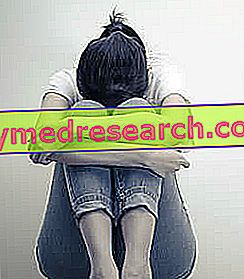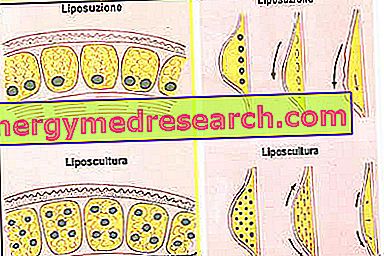Generality
Hysteria is a complex mental disorder characterized by the presence of one or more sensory-motor symptoms (such as, for example, paralysis, blindness and paresthesia), which cannot be justified by a known neurological or internalistic disease.

The mechanism of "conversion" at the base of hysteria is characterized by the lack of control over acts and emotions, and by the exaggeration of the effect of certain sensory stimulations .
Generally, hysterical symptoms consist of obvious deficits that usually involve a motor or sensory function. For example, patients may present: paralysis of an arm or leg, loss of sensation in one part of the body, movement disorders, fatigue, convulsions, blindness, double vision, deafness, aphonia, difficulty swallowing, knot sensation in the throat or urinary retention. These manifestations are serious enough to cause significant suffering or to compromise social and work functioning or other important areas.
The diagnosis of hysteria is taken into consideration only after physical examinations and laboratory tests have excluded organic disorders that can fully justify the symptoms and its effects. Furthermore, the definition of the pathological condition requires that psychological symptoms and emotional problems are associated with the onset of symptoms.
The treatment of hysteria begins by establishing a coherent doctor-patient relationship, and is facilitated by an introspective supportive therapy; psychotherapy can help, as can hypnosis.
Origin of the term and historical outline
- "Hysteria" is a term that has been widely used in nineteenth-century psychiatry to indicate a type of very intense neurotic attacks, of which women were generally victims.
- The term derives from the Greek " Hysteron", which means "uterus", an etymology that underlines the close relationship between this neurosis and the female gender . In ancient Greece, in fact, it was believed that symptoms of this type were caused by a displacement of the uterus. This organ was not considered, in fact, stable in its seat, but could move inside the body for various reasons (including sexual abstinence), pressing on the other organs.
- Starting in the sixteenth century, some doctors began to state that the origin of the disease was dependent on the nervous system and that it could occasionally be detected even in male patients . Gradually, the conviction that it was a "supernatural", exclusively female, disease was therefore abandoned.
- At the beginning of the nineteenth century, the neurologist Babinski emphasized the importance of emotions in the genesis of the disease, while confirming its organic origin. Subsequently, in the "Studies on hysteria", Freud and Breuer explained the disorder as a result of a traumatic experience, usually of a sexual nature, which was removed.
Causes
Hysteria is characterized by the presence of symptoms or deficits that develop unconsciously and involuntarily. The manifestations resemble those of a neurological condition or another physical disorder, but are rarely really related to known pathophysiological or anatomical mechanisms.
In the current classification of the "Diagnostic and Statistical Manual of Mental Disorders", hysteria is referred to as a conversion disorder (formerly also known as "hysterical neurosis").
The subject tends to translate and "convert" his psychological problems into somatic disorders. Of course, the mechanisms that act as the cause of hysteria occur at an unconscious level (therefore the subject is not aware of what is happening): the symptoms of a somatic nature do not therefore have organic, but psychological fundamentals, and manifest themselves independently of the will of the person .
- In hysteria, a repressed feeling, which cannot clearly emerge at the level of consciousness, can thus be translated into a symptom that represents the profound meaning of the psychological obstacle. In other words, the disorders associated with hysteria consist in an attempt to unload the emotional tension created by the psychic conflict, avoiding the conscious perception of the basic problem.
Hysteria tends to arise in the arc between late infancy and early adulthood, although it can occur at any age.
The disorder is more prevalent among women.
How it manifests itself
The hysteria is presented with a complex and polymorphic clinical picture, characterized by the presence of somatic symbols of a symbolic nature, usually in charge of voluntary motor or sensory function, thus suggesting the presence of an underlying neurological or general physical disorder.
These manifestations often begin suddenly; more often than not, the presentation of the disorder is triggered by a stressful event, an emotional conflict or another mental disorder, such as depression. Characteristically, hysteria episodes are short.
Symptoms include:
- Paresthesia located mainly in the limbs;
- Loss of sensitivity in one part of the body;
- Weakness;
- Deafness;
- Blindness and telescope vision;
- Abnormal movements;
- Disorders of coordination or balance;
- Aphonia;
- Difficulty swallowing;
- Sensation of lump in the throat;
- Speech disorders;
- Urinary retention;
- Gastrointestinal disorders;
- Paralysis.
Furthermore, muscle spasms, coarse and rhythmic tremors, choreiform movements, tics, convulsions and epileptic symptoms may be present.
Alterations in consciousness can result from dissociative processes: episodes of somnambulism, multiple personalities, depression and euphoria, delusional states and hallucinations can occur.
Particularly frequent are disorders of memory function, called psychogenic amnesia . Other symptoms include ease of lying, tendency to dramatization and exaggeration, mythomania, simulation, suggestibility, self-centeredness and sexual disorders.
Patients may have a single episode of hysteria or repeated sporadic attacks; the symptoms can become chronic.
Hysterical crisis
A hysterical crisis is a rather rare somatic manifestation characterized by lipotimies, syncopal phenomena or motor expressions. This access is temporary and temporary.
Diagnosis
The diagnosis of hysteria is considered only if a physical examination and laboratory tests have previously excluded organic disorders that can fully justify the symptoms and its effects.
When hysterical disorders mimic a functional disease, the differential diagnosis can be difficult: it is however necessary to exclude that the symptomatology is on an organic basis, before hypothesizing the hysterical origin of the disease.
The sensory-motor manifestations of hysteria must be distinguished from those associated with neurological diseases based on the absence of both objectivable signs and the specific characteristics of distribution of disorders.
The dissociative phenomena of alteration of consciousness are differentiable from those caused by the main brain diseases based on normal results in tests on cognitive functions and following the absence of alterations to computerized tomography (CT), electroencephalographic tracing and magnetic resonance (RM ).
Differential diagnosis
One of the main problems of the diagnostic definition of hysteria is the difficulty and definitively excluding an organic disease. For this reason, careful medical and neurological investigation is necessary.
In the differential diagnosis, neurological disorders (such as dementia and other neurodegenerative diseases), brain tumors and diseases of the basal ganglia (myasthenia gravis, polymyositis, acquired myopathies or multiple sclerosis) must be considered.
Other diseases that can generate uncertain symptoms are: hypochondria, Guillain-Barré syndrome, Creutzfeldt-Jakob disease and initial manifestations of AIDS.
Treatment
In the treatment of hysteria it is essential to establish a therapeutic relationship of trust and support between the patient, a psychiatrist and a doctor from another branch (eg neurologist or internist). After excluding organic causes and reassuring that the symptoms do not indicate a serious underlying disorder, patients may begin to feel better and present an attenuation of the manifestations.
A therapist can help the hysterical person to trace the origin of the disorder and to understand the reasons for his behavior. In some cases, it is necessary to use family therapies, environmental modifications, suggestive techniques (such as hypnosis and narcoanalysis) or the use of short-term psychotherapies.
Hypnosis is a technique that acts on the physical and psychological dimension of the patient; during a session, the health professional can help the subject to experience changes in sensations, perceptions or behavior that help him control the influence of stress and mental state on his bodily functions. Hypnosis thus becomes a means of resolving a psychic situation that causes a difficulty that cannot be solved by will power alone.
Narcoanalysis is a procedure that differs from hypnosis by the administration of a sedative, able to induce a state of drowsiness in the patient.
Furthermore, for some people, psychotherapy is effective, including cognitive-behavioral therapy . This approach is useful as it does not only work on the psychology of the hysterical person, but teaches us to test ourselves in situations that cause anxiety, phobia and emotional conflict. The goal of cognitive-behavioral therapy is to weaken the links between stimuli and the perception of hysterical disorders. This allows you to become aware of your inner conflicts and learn to handle the problem.
Drug therapy only allows the symptoms of hysteria to be attenuated or contained; in this case, the use of anxiolytics, antidepressants and neuroleptics may be useful.



